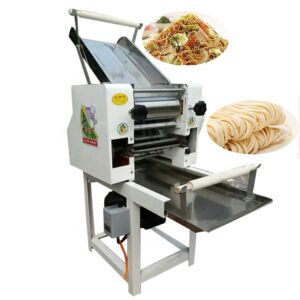 If you’re new to pasta making, understanding the different types of pasta makers can be overwhelming. Each type of pasta maker has its features and benefits, and choosing the right one depends on your needs, budget, and level of expertise.
If you’re new to pasta making, understanding the different types of pasta makers can be overwhelming. Each type of pasta maker has its features and benefits, and choosing the right one depends on your needs, budget, and level of expertise.
Manual Pasta Makers
Manual pasta makers are operated by hand, and you use a crank to roll out the pasta dough. They are the most traditional type of pasta makers and are affordable, easy to use, and give you more control over the pasta dough. Manual pasta makers come with two rollers: one to flatten the dough and one to cut the dough into strips of the desired width. Some manual pasta makers also come with attachments that allow you to create different pasta shapes, such as spaghetti, fettuccine, or tagliatelle.
One of the biggest advantages of using a manual pasta maker is that you can control the thickness of the pasta dough. You can make it as thin or as thick as you like, depending on the type of pasta you want to create. Manual pasta makers are also easy to clean and store, making them perfect for home cooks who want to make pasta occasionally.
Electric Pasta Makers
Electric pasta makers are powered by electricity, making them easier and faster to use than manual pasta makers. They require minimal effort on your part and can roll out pasta dough quicker than manual machines. Electric pasta makers come with several rollers and cutters that allow you to create various pasta shapes, such as spaghetti, fettuccine, lasagna, and more.
One of the biggest advantages of using an electric pasta maker is their convenience. With an electric pasta maker, you can make pasta quickly and with minimal effort, making them perfect for busy home cooks who want to make pasta regularly. Electric pasta makers are also easy to clean and store, and they come with several attachments that allow you to make a variety of pasta shapes.
Pasta Attachments for Stand Mixers
If you already own a stand mixer, you can buy pasta attachments that can convert your mixer into a pasta maker. These attachments are affordable, easy to use, and create a variety of pasta shapes. Pasta attachments for stand mixers come with several rollers and cutters that allow you to create various pasta shapes, such as spaghetti, fettuccine, lasagna, and more.
One of the biggest advantages of using pasta attachments for stand mixers is that they are affordable and convenient. You don’t have to buy a separate pasta maker, and you can use the attachments to create a variety of pasta shapes. Pasta attachments for stand mixers are also easy to clean and store, making them perfect for home cooks who want to make pasta occasionally.
Automatic Pasta Makers
Automatic pasta makers are the most advanced type of pasta makers, and they do everything for you, from mixing the dough to extruding it into pasta shapes. They are the most expensive option but offer the most convenience and speed. Automatic pasta makers come with several rollers and cutters that allow you to create various pasta shapes, such as spaghetti, fettuccine, lasagna, and more.
One of the biggest advantages of using an automatic pasta maker is their convenience. With an automatic pasta maker, you can make pasta quickly and with minimal effort, making them perfect for busy home cooks who want to make pasta regularly. Automatic pasta makers are also easy to clean and store, and they come with several attachments that allow you to make a variety of pasta shapes.
Choosing the right pasta maker depends on your needs, budget, and level of expertise. Pasta attachments for stand mixers are affordable, easy to use, and create a variety of pasta shapes. No matter which type of pasta maker you choose, the result will be fresh, delicious pasta that tastes better than store-bought.